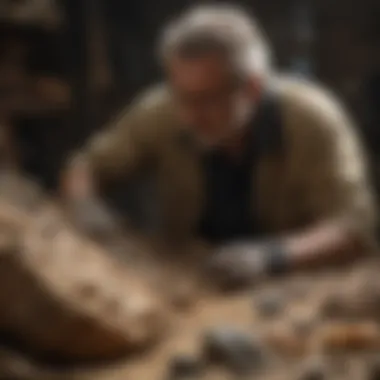Unlocking the Secrets of Rock Cleaning: A Comprehensive Guide for Avid Collectors


Rock and Fossil Identification
For avid collectors passionate about geological specimens, rock and fossil identification is a fundamental aspect of their hobby. Understanding the types of rocks and fossils they encounter is crucial for appreciating their beauty and historical significance. Differentiating between sedimentary, metamorphic, and igneous rocks, as well as various fossil types, requires keen observation and knowledge of characteristics unique to each. Enthusiasts often rely on specialized tools such as magnifying glasses, hardness picks, and UV lights to aid in their identification process.
Collecting Tips and Techniques
To excel in the art of rock collecting, enthusiasts must adhere to best practices and techniques that ensure the ethical and sustainable procurement of specimens. This includes researching and obtaining necessary permissions before entering collecting sites, as well as respecting natural habitats and regulations. Locating prime collecting sites involves geological knowledge and strategic exploration, while safely extracting specimens calls for delicate handling and proper tools like chisels, brushes, and protective gear.
Preservation and Display
Preserving and displaying rocks and fossils play a vital role in maintaining their integrity and aesthetic appeal. Techniques like cleaning with mild soap and water, avoiding harsh chemicals, and utilizing consolidants for fragile specimens are essential for long-term preservation. Proper storage methods such as acid-free paper, archival boxes, and climate-controlled environments help prevent deterioration. Additionally, enthusiasts can get creative with display ideas like shadow boxes, glass domes, or custom shelves to showcase their prized collections.
Geological Insights
Delving into geological insights offers enthusiasts a deeper appreciation of rocks and fossils beyond their visual allure. Understanding the geological formations and processes that shaped these specimens provides insight into Earth's history and evolution. Exploring the historical significance of particular rocks or fossils can unveil narratives of past environments and life forms. Notable discoveries in the field contribute to the collective knowledge of geology, highlighting breakthroughs in understanding Earth's geological timeline and biodiversity.
Introduction
In the fascinating world of rock and fossil collecting, maintaining the beauty and significance of geological specimens is paramount. This article serves as the ultimate guide to rock cleaning, providing meticulous insights and techniques for avid collectors dedicated to preserving the allure of their precious finds. A deep understanding of the cleaning process is essential to not only enhance the visual appeal of rocks and fossils but also to ensure the long-term preservation of their geological integrity.
Understanding the Importance of Rock Cleaning
Preserving Geological Integrity
Preserving the geological integrity of rocks goes beyond mere aesthetics; it is a testament to the authenticity and history encapsulated within each specimen. By carefully cleaning and maintaining the natural features of rocks, collectors can safeguard the integrity of the formations, textures, and mineral compositions that make each piece unique. This meticulous preservation contributes to the overall authenticity and value of the collection, allowing enthusiasts to appreciate the geological significance of their specimens on a deeper level.
Enhancing Visual Appeal
Enhancing the visual appeal of rocks through thorough cleaning techniques not only aids in revealing the true beauty of each specimen but also allows collectors to showcase their treasures with pride. By removing accumulated dirt, grime, and debris from the surface, the vibrant colors, intricate patterns, and lustrous textures inherent in the rocks can be fully revealed. This process not only revitalizes the aesthetic appeal of the rocks but also offers collectors the opportunity to enjoy their collection in its most pristine and visually captivating state.
Essential Tools for Rock Cleaning
In the meticulous world of rock cleaning, having the right tools at your disposal is paramount to ensuring the preservation and visual appeal of your geological specimens. The section on Essential Tools for Rock Cleaning within this comprehensive guide delves into the fundamental instruments that every collector should possess. These tools not only aid in the meticulous cleaning process but also play a significant role in maintaining the integrity of the rocks and fossils. From gently removing surface dirt to unveiling the hidden beauty beneath, the essential tools discussed in this article are essential companions for any avid collector on their rock cleaning journey.
Basic Equipment Every Collector Should Have


Toothbrushes and Soft-bristled Brushes
When it comes to rock cleaning, toothbrushes and soft-bristled brushes are indispensable tools that delicately scrub away dirt and grime without causing damage to the rock's surface. Their soft bristles ensure a gentle yet effective cleaning process, allowing collectors to meticulously clean even the most delicate geological specimens. The key characteristic of toothbrushes and soft-bristled brushes lies in their ability to reach crevices and intricate patterns on rocks, providing a thorough cleaning experience. Their popularity stems from their versatility and non-abrasive nature, making them a preferred choice for delicate rocks and fossils. While the unique feature of these tools lies in their soft bristles, collectors must be cautious not to apply excessive pressure during cleaning to prevent unintentional scratches or abrasions to the rock's surface.
Mild Detergents and Cleaning Solutions
Mild detergents and cleaning solutions serve as crucial companions in the rock cleaning process, offering a gentle yet effective way to remove stubborn dirt and stains from geological specimens. Their key characteristic lies in their ability to effectively break down grime without causing harm to the rock's surface, ensuring a safe cleaning experience for collectors. The popularity of mild detergents and cleaning solutions in rock cleaning stems from their efficiency in lifting dirt while being mild enough to preserve the geological integrity of the specimens. One unique feature of these solutions is their ability to emulsify and lift dirt particles, making them ideal for thorough cleaning. However, collectors should be mindful of using the correct dilutions and avoiding harsh chemicals that could potentially harm the rocks.
Water Sprayer or Spray Bottle
A water sprayer or spray bottle is a versatile tool that plays a key role in the rock cleaning process by providing a gentle and controlled stream of water for rinsing off cleaning solutions and dirt residue. Its key characteristic lies in its ability to deliver a precise amount of water, ensuring thorough rinsing without excess moisture that could damage the rocks. The popularity of using a water sprayer or spray bottle for rock cleaning is due to their efficiency in rinsing off cleaning agents while allowing collectors to target specific areas for thorough cleaning. A unique feature of these tools is their adjustable nozzles, which enable collectors to regulate the flow of water depending on the cleaning requirements. However, caution must be exercised to prevent excessive water pressure that could potentially harm fragile rock surfaces during the cleaning process.
Preparation Techniques Before Cleaning
In the realm of rock cleaning, preparation techniques play a vital role in setting the stage for a successful cleaning process. Before delving into the actual cleaning methods, it is crucial to take the time to inspect the rock surface thoroughly. This step is imperative for identifying any fragile areas that may require special attention during cleaning. By focusing on this preparatory phase, collectors can prevent potential damage to delicate rock formations and ensure an effective cleaning outcome.
Additionally, removing loose debris before initiating the cleaning process is essential. Loose debris such as dirt, sand, or other particles can hinder the cleaning process and may even scratch the rock surface if not addressed beforehand. By carefully removing these debris pieces, collectors can maintain the integrity of the rock surface and prevent unnecessary damage.
Inspecting the Rock Surface
Identifying Fragile Areas
When it comes to inspecting the rock surface, identifying fragile areas is a critical aspect that cannot be overlooked. Fragile areas are sections of the rock that are prone to damage or breakage if not handled with care during the cleaning process. By pinpointing these vulnerable spots, collectors can tailor their cleaning approach to ensure gentle yet effective cleaning.
A key characteristic of identifying fragile areas is the keen observation and understanding of the rock's composition and structure. By recognizing weak points or areas that may be susceptible to damage, collectors can adjust their cleaning techniques to protect these delicate sections. This attention to detail not only prevents unwanted breakage but also promotes a thorough and mindful cleaning process.
Removing Loose Debris
Removing loose debris contributes significantly to the overall cleaning goal by creating a clean canvas for the subsequent cleaning steps. The key characteristic of this step lies in the meticulous approach to detail – ensuring that all loose debris is cleared from the rock surface without causing any abrasions or scratches. By gently clearing away dirt, sand, or small particles, collectors pave the way for a more effective and precise cleaning process.
One unique feature of removing loose debris is its role in enhancing the visual appeal of the rock. By eliminating distracting elements on the surface, collectors can reveal the true beauty and intricate details of the rock underneath. However, it is essential to handle this step with care to avoid unintentional damage to the rock surface, underscoring the importance of a delicate touch in the cleaning process.
Methods for Gentle Cleaning
In the realm of rock cleaning, the methods employed play a crucial role in ensuring the preservation and enhancement of geological specimens. Within the framework of this comprehensive guide to rock cleaning for avid collectors, the section on Methods for Gentle Cleaning holds significant importance. By focusing on gentle cleaning techniques, collectors can delicately remove debris and dirt from rocks without causing damage. This section delves into specific elements, benefits, and considerations regarding gentle cleaning methods to provide a holistic approach to maintaining the allure of rocks and fossils.
Brushing and Wiping Techniques


Using Soft Brushes in Circular Motions
Delving deeper into the art of rock cleaning, the technique of Using Soft Brushes in Circular Motions emerges as a fundamental aspect of gentle cleaning methods. This technique involves the use of soft-bristled brushes to delicately remove dirt and debris from the surface of rocks in gentle circular motions. The key characteristic of Using Soft Brushes in Circular Motions lies in its ability to clean effectively without causing scratches or abrasions on the surface of the rock. A popular choice among collectors, this method ensures thorough cleaning while maintaining the integrity of the geological specimen. The unique feature of Using Soft Brushes in Circular Motions lies in its gentle yet effective cleaning action, making it a beneficial choice for delicate rocks and fossils. While it offers meticulous cleaning, it is essential to handle this method with care to prevent any unintended damage.
Lightly Wiping with Damp Cloth
Another vital aspect of gentle cleaning techniques is Lightly Wiping with a Damp Cloth. This method involves lightly wiping the surface of rocks with a damp cloth to remove surface dirt and grime. The key characteristic of this technique is its ability to swiftly clean rocks without the need for harsh abrasives. A beneficial choice for fragile or easily damaged specimens, Lightly Wiping with a Damp Cloth ensures a gentle yet effective cleaning process. The unique feature of this method is its simplicity and efficiency in removing superficial dirt, contributing to the overall cleaning regimen. While it offers a convenient way to clean rocks, care must be taken to ensure the cloth is damp and not dripping wet to prevent excess moisture from seeping into the rock, potentially causing harm.
Advanced Cleaning Approaches:
In this comprehensive rock cleaning guide for avid collectors, exploring advanced cleaning approaches is crucial to maintaining the allure of geological specimens. Advanced techniques offer meticulous cleaning methods that go beyond surface-level dirt removal, ensuring the rocks and fossils are restored to their optimal condition. By delving into advanced cleaning approaches, collectors can elevate their cleaning processes to preserve the geological integrity and visual appeal of their prized specimens.
Using Ultrasonic Cleaners:
Understanding Ultrasonic Technology:
The utilization of ultrasonic cleaners is a pivotal aspect of advanced cleaning approaches in this article. Ultrasonic technology relies on high-frequency sound waves to create cavitation bubbles that gently but effectively cleanse materials without causing damage. The key characteristic of ultrasonic technology is its ability to reach intricate crevices and remove stubborn contaminants with precision, making it a popular choice for meticulous rock cleaning. This technology's unique feature lies in its non-invasive cleaning method, ensuring thorough cleaning without altering the rock's surface composition. While ultrasonic cleaners offer significant benefits in enhancing cleaning efficiency and effectiveness, precautions such as appropriate settings and monitoring the cleaning duration are essential to prevent any potential damage to fragile specimens.
Benefits and Precautions:
The benefits of using ultrasonic cleaners are evident in their ability to clean hard-to-reach areas effectively, providing a thorough and consistent cleaning method for rocks and fossils. However, precautions must be taken to ensure that the frequency and power levels are suitable for the specific specimen being cleaned. While ultrasonic technology offers benefits such as time efficiency and meticulous cleaning results, precautions include avoiding prolonged exposure to high-intensity ultrasonic waves that may compromise the integrity of delicate specimens. By balancing the benefits and precautions associated with ultrasonic cleaning, collectors can achieve optimal cleaning outcomes while safeguarding their geological treasures.
Abrasive Techniques for Stubborn Deposits:
Sandblasting and Grinding:
In the realm of advanced cleaning approaches, abrasive techniques like sandblasting and grinding play a crucial role in tackling stubborn deposits on rocks and fossils. Sandblasting involves propelling abrasive materials against the surface at high speeds to remove tough stains or encrustations effectively. The key characteristic of sandblasting and grinding lies in their ability to offer efficient cleaning solutions for heavily soiled specimens, making them a preferred choice for collectors dealing with stubborn deposits. The unique feature of these abrasive techniques is their targeted approach towards specific areas, allowing collectors to address localized challenges without compromising the entire surface of the rock. However, it is essential to be cautious with the intensity of abrasives used and ensure proper equipment to avoid damaging the rock surface during cleaning.
Avoiding Damage to Rock Surface:
While abrasive techniques like sandblasting and grinding can effectively address stubborn deposits, careful consideration must be given to avoiding any potential damage to the rock surface. The key characteristic of this precaution lies in preserving the natural textures and features of the rock while removing unwanted deposits, ensuring the overall aesthetic appeal remains intact. By adopting precise control over abrasive intensity and duration, collectors can prevent unintended damage to the rock's surface during cleaning. The unique feature of this preventive measure is its balance between removing stubborn deposits and safeguarding the inherent characteristics of the rock, offering a delicate yet effective cleaning approach. By incorporating precautions to avoid damage to the rock surface, collectors can maintain the structural integrity and visual beauty of their geological specimens throughout the cleaning process.
Drying and Polishing After Cleaning
In the realm of rock cleaning for avid collectors, the process of drying and polishing after cleaning plays a pivotal role. This crucial step ensures that the rocks and fossils not only maintain their visual appeal but also continue to be preserved effectively for years to come. By focusing on this aspect, collectors can elevate the aesthetics of their specimens while also safeguarding their geological integrity.


Air-drying Methods
Natural Air-drying
Natural air-drying emerges as a fundamental technique in the post-cleaning phase. This method involves allowing the rocks to air dry, harnessing the natural environment to facilitate the process. One of the key characteristics of natural air-drying is its gentle approach, which prevents any potential damage that could arise from more aggressive drying methods. Its popularity in this context stems from its simplicity and its ability to preserve the delicate surfaces of rocks effectively. While the advantage of natural air-drying lies in its non-intrusive nature and cost-effectiveness, it is essential to be mindful of external factors, such as humidity levels, that may impact the drying process.
Using Compressed Air
Another valuable technique for drying rocks post-cleaning is utilizing compressed air. This method involves using controlled bursts of compressed air to remove excess water from intricate crevices and hard-to-reach areas. The key characteristic of using compressed air is its precision in targeting specific areas that may be difficult to dry through conventional means. Its effectiveness lies in expediting the drying process and reaching areas that might be inaccessible to traditional drying methods. While the advantage of using compressed air includes its efficiency and versatility, collectors need to exercise caution to avoid damaging fragile surfaces with excessive air pressure.
Polishing for a Lustrous Finish
As collectors seek to enhance the visual appeal of their rocks and fossils, the step of polishing becomes indispensable. By incorporating polishing techniques, enthusiasts can achieve a lustrous finish that accentuates the natural beauty of the specimens. This phase not only elevates the aesthetic charm of the rocks but also serves to protect the surface from environmental factors.
Buffing with Soft Cloth
Buffing with a soft cloth stands out as a meticulous process that involves gently rubbing the surface of the rock to achieve a polished finish. The key characteristic of this method is its ability to remove minor imperfections and bring out the vibrant colors and textures of the specimen. Its popularity in this context stems from its accessibility and simplicity, making it an ideal choice for collectors looking to add a subtle sheen to their rocks. The advantage of buffing with a soft cloth lies in its non-abrasive nature, which helps preserve the integrity of the rock surface, although care must be taken to ensure uniform pressure to avoid unintended scratches.
Applying Mineral Oil
Applying mineral oil serves as a refined technique to impart a glossy sheen to rocks and fossils. The key characteristic of this approach is its ability to enhance the inherent colors and patterns of the specimens while providing a protective layer against moisture and dust. Its popularity in rock cleaning lies in its ability to rejuvenate dull surfaces and bring out the intricate details embedded in the rock. The advantage of applying mineral oil includes its long-lasting effects and its suitability for a wide range of rock types. However, collectors should be cautious with the amount of oil applied to prevent residue buildup and potential alteration of the rock's natural appearance.
Final Tips and Considerations
In the realm of rock cleaning for avid collectors, the Final Tips and Considerations section holds paramount importance, serving as the culmination of essential knowledge needed for maintaining the allure and integrity of geological specimens. This segment offers invaluable insights into ensuring the long-term quality of rocks and fossils, emphasizing prudent practices to uphold their beauty and geological significance, reflecting the meticulous dedication of enthusiasts committed to preserving these natural wonders.
Maintaining Long-term Rock Quality
Storing in Suitable Containers
The practice of storing rocks and fossils in appropriate containers stands as a critical facet in safeguarding their longevity and pristine condition. By choosing containers that provide adequate protection from external elements such as moisture, sunlight, and physical damage, collectors can effectively prevent deterioration and maintain the rocks' visual appeal and geological integrity. Utilizing airtight containers made of non-reactive materials like plastic or glass helps in preserving the composition of the specimens while shielding them from environmental factors that could compromise their quality.
Regular Inspection and Cleaning Schedule
Establishing a routine for regular inspection and cleaning is vital in ensuring the ongoing maintenance of rock quality. By conducting frequent inspections, collectors can promptly address any signs of degradation, such as dust accumulation or surface blemishes, preserving the rocks' pristine state. Additionally, implementing a consistent cleaning schedule allows for the removal of dirt and impurities that may dull the rocks' appearance over time, ensuring they remain visually striking and geologically authentic.
Seeking Professional Assistance
In certain instances where collectors encounter challenges beyond their expertise, seeking professional assistance from expert geologists becomes instrumental in securing the longevity and vitality of their rock collections. Consulting with experienced geologists provides access to specialized knowledge and techniques tailored to the unique care requirements of different rock types, offering invaluable guidance on preservation methods and restoration techniques specific to individual specimens.
Utilizing Conservation Services
The utilization of conservation services offers collectors the opportunity to avail themselves of professional expertise in the restoration and preservation of rocks and fossils. Conservation services employ specialized equipment and restoration processes designed to enhance the visual appeal and structural integrity of geological specimens, ensuring they are maintained in optimal condition for long-term display and enjoyment. While outsourcing conservation services may entail additional costs, the benefits of expert care and preservation expertise far outweigh the investment, guaranteeing the continued beauty and value of precious rock collections.







